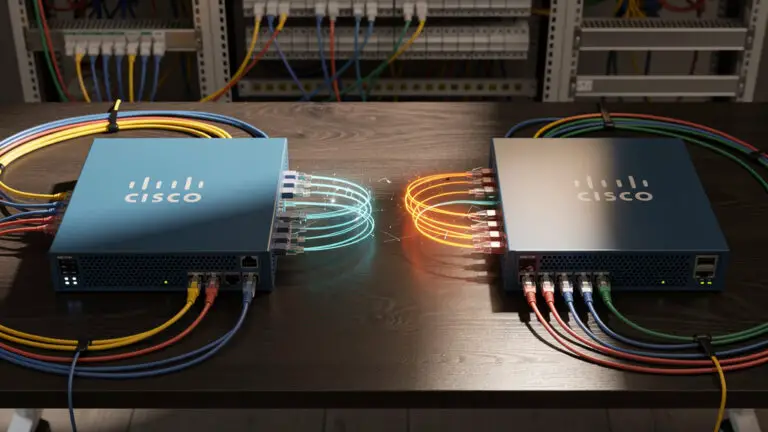How Does Google WiFi Work? Google Nest WiFi operates on a mesh network system to spread a strong and consistent internet connection throughout your home. Today’s lineup spans older Google Wifi/Nest Wifi (Wi‑Fi 5) and the newer Nest Wifi Pro (Wi‑Fi 6E). This guide explains the differences, coverage planning, setup steps, and features so you can choose and set up the right mesh for your home.
This guide will detail the mesh technology, calculate the number of access points needed, and provide a simple setup tutorial. We’ll also explore key features that enhance your online experience. Read on for a detailed understanding of Google Nest WiFi and how it can serve your home internet needs, including what’s new with Nest Wifi Pro.






Key Takeaways – How Does Google WiFi Work?
- Google/Nest WiFi uses a mesh network to provide whole-home coverage; multiple routers (“points”) work together under one network name.
- Nest Wifi Pro supports Wi‑Fi 6E (2.4/5/6 GHz) and includes Thread/Matter for smart-home reliability; earlier Nest Wifi (2019) and Google Wifi (2016/2020) are Wi‑Fi 5.
- Compatibility note: Nest Wifi Pro cannot be mixed with older Nest Wifi/Google Wifi in the same mesh. Older Nest Wifi and Google Wifi can be mixed together.
- Coverage guidance (Pro): about 2,200 sq ft per router; 2‑pack ~4,400 sq ft; 3‑pack ~6,600 sq ft. Placement matters more than floors.
- Easy app setup in Google Home. If your modem is also a router, use bridge/passthrough on the ISP gateway to avoid double NAT. Mesh requires Nest in router mode.
- Useful features: parental controls, speed tests, guest network, device prioritization, automatic updates, and Google Home voice control.
- Hardware notes: Nest Wifi Pro and Nest Wifi routers include two 1 Gbps Ethernet ports; Nest Wifi points (2019) have no Ethernet.
- Ideal for larger or complex homes. For small apartments with good single‑router coverage, a quality standalone router may suffice.
- Pricing (MSRP): Nest Wifi Pro $199.99 single, $299.99 2‑pack, $399.99 3‑pack. No monthly fees; works with any internet provider.
- Limitation: Nest Wifi Pro Ethernet ports are 1 Gbps; multi‑gig ISP plans won’t see full wired throughput.
What is Google WiFi and Google Nest WiFi?
Google Wifi, Nest Wifi (2019), and Nest Wifi Pro (2022) are modular mesh systems that expand fast Wi‑Fi throughout your home using multiple routers (“nodes/points”) that create one unified network. The newest model, Nest Wifi Pro, adds Wi‑Fi 6E plus Thread/Matter for smarter, more reliable connected homes.
The key benefit is eliminating Wi‑Fi dead zones by spreading a strong signal to every corner of your house. You can stream 4K in the living room while someone games in the basement with minimal congestion or lag when sized and placed correctly.
See also: https://afrozahmad.com/blog/google-wifi-review/
How Does the Google WiFi Mesh Network Work?
Google/Nest WiFi works through a chain of Wi‑Fi routers placed strategically around your home. Here’s how it works:
- The primary router connects directly to your internet modem or gateway and broadcasts your main Wi‑Fi network.
- Additional routers (points) are placed in open areas 2–3 rooms apart to extend coverage and maintain a strong backhaul.
- All routers communicate to present a single network name with seamless roaming as you move around.
- It’s easily expandable, but note that Nest Wifi Pro (Wi‑Fi 6E) cannot be mixed with older Nest Wifi/Google Wifi (Wi‑Fi 5). Older Nest Wifi can mix with Google Wifi.
- Manage everything in the Google Home app with one Google account.
In practice, it behaves like multiple coordinated routers that blanket your home. For best results, size by square footage and building materials instead of strictly “one per floor.”
Check out our article WiFi Mesh vs Extender vs Booster vs Repeater: Which Is Best For Your Home? article to compare other options.
How Many Google Nest WiFi Nodes Do You Need?
The number of access points needed depends on your home’s size and layout:
- For small homes or apartments (around 1,000–1,500 sq ft), start with 1 router (Nest Wifi Pro covers ~2,200 sq ft).
- For larger spaces or 2–3 bedrooms, a 2‑pack (~4,400 sq ft on Pro) is a common sweet spot.
- For big or complex layouts, a 3‑pack (~6,600 sq ft on Pro) helps fill in tricky areas; add more only as needed. More than five routers in one network can degrade performance.
Google Wi‑Fi meshes shine in larger homes that need expanded coverage. For small, open layouts, a single upgraded router can be enough.
Step-by-Step Guide to Setting Up Google Nest WiFi
Installing Google/Nest Wi‑Fi takes just a few simple steps:
- Download the Google Home app on your phone (Android and iOS).
- Set up a home in the app if you’re a first-time user.
- Place your primary Wi‑Fi router near your modem or gateway and connect them with an Ethernet cable.
- If your ISP device is a modem/router combo, put it in bridge or passthrough mode to avoid double NAT. Keep Nest in router mode to enable mesh features.
- Plug in the Nest router and wait for the light to pulse blue (ready for setup).
- Open the Google Home app and select Add > Set up device > New device to find your router.
- Scan the QR code on the bottom, then name your network and set a password.
- Place additional routers around your home; the app will test placement and link them to the primary.
That’s it! The app walks you through the process and lets you expand anytime by adding more routers.
Setup is done exclusively with the Google Home app. The Google WiFi Provisioner app was for legacy provisioning and isn’t used for Nest Wifi or Nest Wifi Pro mesh setups.
Handy Features of Google Nest Wi‑Fi
In addition to providing seamless coverage, Google/Nest Wi‑Fi offers useful features:
- Ethernet Ports: Nest Wifi Pro and Nest Wifi routers include two Gigabit Ethernet ports; Nest Wifi points (2019) have no Ethernet.
- Network Assist – Automatically optimizes performance and steers devices to the best radio/node.
- Prioritize Devices – Temporarily prioritize traffic for smoother calls and gaming.
- Guest Network – Create a separate network for visitors.
- Parental Controls – Set content filters, usage limits, and pause the internet.
- Automatic Updates – Security and performance updates install automatically.
- Smart home – Control via Google Home voice; Nest Wifi Pro adds Thread/Matter for more reliable smart devices.
- Speed testing – Check your mesh performance from the app.
Wi‑Fi Point or Mesh Network? What’s the Difference?
Before deciding between a mesh system and an extender, it helps to understand the key differences:
- Wi‑Fi extenders repeat an existing signal and create a separate network; they can reduce throughput and often leave gaps.
- Mesh networks like Google/Nest create a unified network with multiple access points that work together for consistent coverage.
- Mesh handles multiple devices better by distributing demand and offering Ethernet or wireless backhaul between routers.
- Mesh is easy to expand by adding compatible routers; follow model‑compatibility rules noted above.
For most homes, a mesh network like Google/Nest provides better performance and flexibility than extenders.
Pros of Google Nest Wi‑Fi
Here are the main benefits that make Google/Nest Wi‑Fi an appealing choice:
- Whole home coverage 📡 – Say goodbye to Wi‑Fi dead zones.
- Easy setup 💨- Guided install in the Google Home app.
- Modular and expandable – Add more compatible routers anytime.
- Lag-free performance – Stream, game, and video call smoothly when sized/placed well.
- Single network – One SSID with seamless roaming.
- Smart-home ready – Nest Wifi Pro adds Thread/Matter for reliable device control.
- Guest network & parental controls – Built-in management features.
- Automatic updates – Hands‑off security and feature updates.
- Google Home voice control – Manage basics hands‑free.
Cons of Google Nest Wi‑Fi
Here are some downsides to consider:
- May be overkill for small spaces – Apartments with good single‑router coverage may not need mesh.
- Price – Nest Wifi Pro MSRP: $199.99 (single), $299.99 (2‑pack), $399.99 (3‑pack).
- No USB port – Can’t directly share storage or printers via USB.
- Google account required – Needed for setup and management.
- Model differences – Nest Wifi Pro is Wi‑Fi 6E; older Nest/Google Wifi are Wi‑Fi 5. Pro units cannot be mixed with older units in one mesh.
- Port limitation – Nest Wifi Pro Ethernet ports are 1 Gbps; not ideal for >1 Gbps wired plans.
Conclusion
In summary, Google/Nest Wi‑Fi provides mesh coverage that blankets your home with reliable Wi‑Fi. Nest Wifi Pro brings Wi‑Fi 6E and smart‑home upgrades (Thread/Matter), while older Google/Nest systems remain solid for basic needs.
The easy setup, expandability, and built‑in controls make Google/Nest Wi‑Fi an excellent choice for larger homes or tricky layouts. If you’ve struggled with spotty coverage, a properly sized and placed mesh can deliver the consistent speeds you’re after.
So, if you’re dealing with Wi‑Fi range issues, Google/Nest Wi‑Fi can be the ideal solution for achieving full‑home coverage—just be sure to pick the right generation and follow the placement and compatibility guidance above.
FAQs about Google Nest Wi‑Fi
Does Google Wi‑Fi replace my existing router?
Yes. The primary Nest/Google Wi‑Fi router replaces your current router for Wi‑Fi coverage. You still need your modem or ISP connection.
Do you have to pay monthly for google wifi?
No. There’s no monthly fee for Google/Nest Wi‑Fi—only the hardware cost. You still pay your ISP for internet service.
What exactly does google wifi do?
It creates a mesh network by linking multiple routers to blanket your home with fast, reliable Wi‑Fi under one network name.
Can i use google wifi without an internet provider?
No. Google/Nest Wi‑Fi doesn’t provide internet service; it works with your ISP connection from any provider.
Can you use google mesh with your own router?
Yes, but avoid double NAT. Ideally, put your ISP gateway in bridge/passthrough and run Nest/Google Wi‑Fi in router mode. Bridge mode on Nest supports only a single device and disables mesh features.
Is there a monthly fee for Google Wi‑Fi?
No. There’s no subscription for the mesh system itself—only your ISP bill.
Will Google Wi‑Fi work with my provider?
Yes. Google/Nest Wi‑Fi works with any ISP. Connect the WAN port to your modem or bridged gateway to start setup in the Google Home app.
Is Google Wi‑Fi worth it?
For larger homes with spotty coverage, a properly planned Google/Nest mesh delivers strong, consistent Wi‑Fi and simple management.
Does Google Wi‑Fi work with Alexa?
Google/Nest Wi‑Fi is designed for the Google Home ecosystem and isn’t Alexa‑native. Manage and voice‑control basics with Google Home; no power‑cycling workarounds are recommended.
- 10 Best Network Switches for Home Networks in 2026 (Top Picks) - December 24, 2025
- 7 Best Budget Routers For Small Business Networks (Under $200) - December 22, 2025
- How to Configure a Secure Site-to-Site VPN on Cisco Firepower Complete Guide - December 3, 2025




